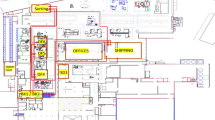Abstract
In the 300 mm AMHS with a connected loops layout, the vehicle can travel not just in one loop but all around the wide fab to execute tool-to-tool delivery. Determining how far the waiting FOUPs (WFs) or idle vehicles (IVs) should be considered before selecting a dispatching rule might make dispatching more efficient. A two-phase approach with simulation has been developed to assign the search range (SR) for studying this idea. The model of a simplified 300 mm AMHS was built using eM-Plant and Design Expert to design experiments and analyse the results. In phase I, the number of WF and IV in the system at the time of dispatching will affect the distance of the vehicle’s empty trip (DVemp). Further, the SR was assigned and evaluated based on the average and standard deviation of DVemp under different numbers of WF and IV in phase II. The results indicated that the SR significantly affects the performance, and a longer SR used in a light system is feasible; a shorter SR is applicable for a heavy system.
Similar content being viewed by others
Abbreviations
- AMHS:
-
automated material handling system
- OHT:
-
overhead hoist transporter
- OHS:
-
overhead shutter
- FOUP:
-
front-opening unified pod
- MES:
-
manufacturing execution system
- FEFS:
-
dispatching rule based on foremost encounter first served
- NV:
-
dispatching rule based on the nearest vehicle
- MR:
-
moving rate
- SR:
-
search range
- FSV:
-
FOUP search vehicle
- VSF:
-
vehicle search FOUP
- Dvemp :
-
distance of vehicle’s empty trip
- WF :
-
waiting FOUP
- IV :
-
idle vehicle
- LSD:
-
the least significant difference
References
Binder H, Honold A (1999) Automation and fab concepts for 300 mm wafer manufacturing. Microelectron Eng 45(2/3):91–100
Kaempf U (1997) Automated wafer transport in the wafer Fab. Advanced Semiconductor Manufacturing Conference and Workshop, IEEE, pp 356–361
Kurosaki R, Nagao N, Komada H, Watanabe Y, Yano H (1997) AMHS for 300 mm wafer. Proc International Symposium on Semiconductor Manufacturing Conference, pp D13–D16
Campbell E, Ammenheuser J (2000) 300 mm factory layout and material handling modeling: Phase II report. International SEMATECH, technology transfer # 99113848B-ENG
Bahri N, Reiss J, Doherty B (2001) A comparison of unified vs. segregated automated material handling systems for 300 mm fabs. Proc International Symposium on Semiconductor Manufacturing Conference, pp 3–6
Maxwell WL, Muckstadt JA (1982) Design of automatic guided vehicle systems. IIE Trans 14(2):114–124
Egbelu PJ (1987) The use of non-simulation approaches in estimating vehicle requirements in an automated guided vehicle based transport system. Mater Flow 4:17–32
Arifin R, Egbelu PJ (2000) Determination of vehicle requirements in automated guided vehicle systems: a statistical approach. Prod Plan Control 11(3):258–270
Lin JT, Wang FK, Wu CK (2003a) Connecting transport AMHS in a wafer fab. Int J Prod Res 41(3):529–544
Wang FK, Lin JT (2004) Performance evaluation of an automated material handling system for a wafer fab. Robot Comput Integr Manuf 20(2):91–100
Fukunari M, Rajanna S, Gaskins RJ, Sparrow ME (2002) Data-based node penalties in a path-finding algorithm in an automated material handling system. Proc 2002 Winter Simulation Conference, pp 1383–1386
Bahri N, Gaskins RJ (2000) Automated material handling system traffic control by means of node balancing. Proc 2000 Winter Simulation Conference, pp 1344–1346
Lin JT, Wang FK, Yang CJ (2005) The performance of the number of vehicles in a dynamic connecting transport AMHS. Int J Prod Res 43(11):2263–2276
Lin JT, Wang FK, Wu CK (2003.b) Simulation analysis of the connecting transport AMHS in a wafer fab. IEEE Trans Semiconductor Manuf 16(3):555–564
Lin JT, Wang FK, Young JR (2004) Virtual vehicle in the connecting transport automated material-handling system (AMHS). Int J Prod Res 42(13):2599–2610
Lin JT, Wang FK, Yen PY (2001) Simulation analysis of dispatching rules for an automated interbay material handling system in wafer fab. Int J Prod Res 39(6):1221–1223
Wang CN, Liao DY (2003) Effective OHT dispatching for differentiated material handling services in 300 mm wafer foundry. Proceedings of the 2003 IEEE international conference on Robotics and Automation, pp 1027–1032
Wang CN, Liao DY (2004) Differentiated automatic materials handling services in 300 mm semiconductor foundry. Conference 2004 of Operations Research Society in Taiwan, pp 105–113
Lin JT, Wang FK, Chang YM (2006) A hybrid push/pull-dispatching rule for a photobay in a 300 mm wafer fab. Robot CIM-Int Manuf 22:47–55
Egbelu PJ, Tanchoco JMA (1984) Characterization of automatic guided vehicle dispatching rules. Int J Prod Res 22(3):359–374
Plant EM (2001) Objects manual, version 4.6. Tecnomatix Technologies GmbH & Co, Stuttgart, Germany
Montgomery DC (2001) Design and analysis of experiments. Wiley, New York
Myers RH, Montgomery DC (1995) Response surface methodology: process and product optimization using designed experiments. Wiley, New York
StatEase (2001) Design expert user’s manual, version 6.04. StatEast, Minneapolis
Acknowledgements
The authors gratefully acknowledge the consultation made with the UMC Corporation at Taiwan, R.O.C. and the subvention from National Science (NSC) project: NSC 94-2213-E-009-084.
Author information
Authors and Affiliations
Corresponding author
Rights and permissions
About this article
Cite this article
Sha, D.Y., Lin, J.T. & Yang, C.J. The evaluation of search range assignment in 300 mm automated material handling system (AMHS). Int J Adv Manuf Technol 35, 697–710 (2008). https://doi.org/10.1007/s00170-006-0747-4
Received:
Accepted:
Published:
Issue Date:
DOI: https://doi.org/10.1007/s00170-006-0747-4




